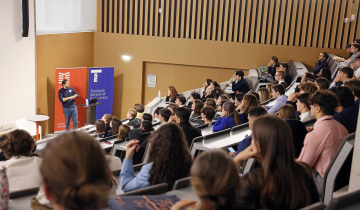
Professor Olivier DE GROOTE will defend his HDR on Friday 14 November at 10:00, by ZOOM
"The Consequences of Forward-Looking Behavior and Policies: Evidence and Design in Green Technology Adoption and Education"
To attend the conference, please contact the secretariat Christelle Fotso Tatchum.
Memberships are:
Thierry MAGNAC: Professor of Economics, Ecole TSE, University Toulouse Capitole
Koen JOCHMANS : Professor of Economics, Ecole TSE, University Toulouse Capitole
Estelle CANTILLON : Senior Researcher, Université Libre de Bruxelles
Catarina CALSAMIGLIA :Professor of Economics, Barcelona School of Economics
Julien COMBE : Assistant Professor in Economics, Ecole Polytechnique
Abstract
I am an empirical microeconomist specializing in labor economics and empirical industrial organization, with related work in environmental and education economics. I also contribute to the literature on the estimation of dynamic discrete choice models. My research aims to understand how to design optimal public policies when individuals make decisions with long-term consequences. It revolves around three main themes: (1) the adoption of green technologies, (2) the matching between students and educational tracks, and (3) the development of practical estimators for complex dynamic discrete choice problems. The focus of these themes has gradually shifted from (1) to (2), while (3) has remained central.
I have published the three papers from my PhD in leading economics journals, along with one additional publication, and I have completed three other papers currently under revision or review.
In “Subsidies and Time Discounting in New Technology Adoption: Evidence from Solar Photovoltaic Systems” (with Frank Verboven, AER), we study a generous Belgian subsidy program promoting solar photovoltaic adoption through future production subsidies rather than upfront investment grants. Using a dynamic model of technology adoption, we identify households’ discount factors and show that they heavily discount future benefits. As a result, upfront investment subsidies would have achieved similar adoption at a lower fiscal cost.
With Verboven and Axel Gautier, I extended this work in “The Political Economy of Financing Climate Policy” (Resource and Energy Economics), showing that voters punished the government for an overly costly subsidy program, particularly in municipalities with high adoption rates.
An increasing share of my work focuses on education economics. In “Tracking and Specialization of High Schools: Heterogeneous Effects of School Choice” (with Koen Declercq, Journal of Applied Econometrics), we analyze the impact of enrolling in elite high schools in a tracked system in Flanders. We find that students’ graduation probability rises on average, but effects are heterogeneous: those who would naturally choose elite schools gain little, while others would benefit substantially.
My job market paper, “Dynamic Effort Choice in High School: Costs and Benefits of an Academic Track” (Journal of Labor Economics), develops a dynamic discrete choice model incorporating unobserved effort. A policy encouraging struggling students to switch to less academic tracks reduces grade repetition by one-third and dropout by 11%, with no significant effect
on the probability of obtaining a higher education degree. Modeling effort proves crucial: omitting it would underestimate effects on repetition and dropout while overstating effects on higher education.
In “School Choice and Class-Size Effects: Unintended Consequences of a Targeted Voucher Program” (with Ana Gazmuri), we propose a new method to estimate education production functions from observational data in a school choice context. Using Chilean school panel data, we show that smaller class sizes following a voucher reform partly explain observed improvements in test scores.
In “Sequential College Admission Mechanisms and Off-Platform Options” (with Anaïs Fabre, Margaux Luflade, and Arnaud Maurel), we study French college admission platforms. Modeling students’ waiting and acceptance decisions, we find that waiting costs are high—especially for disadvantaged students—but that multi-round systems improve welfare and student-program matching.
Finally, in “Matching Disadvantaged Children to Day Care: Evidence from a Centralized Platform” (with Minyoung Rho), we use parental preference lists and daycare admission data to estimate the preferences and priorities of parents and providers. Our analysis shows that affirmative action policies are crucial to increase participation of disadvantaged children, even though they may raise segregation due to location preferences.



